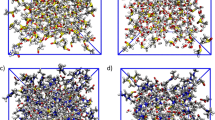Abstract
The effects of urea, guanidinium chloride, and potassium chloride on the solution properties of caffeine have been investigated by solubility and partition experiments and by measuring heats of dilution, solution, and mixing. Thermodynamic transfer properties are used to discuss the possible mechanism of action of the two denaturants. The ability of caffeine to form stacked aggregates is taken as possible evidence for a direct interaction of this solute with urea and guanidinium ion. The data are discussed both in terms of an ideally associating system and in terms of the virial expansion following the McMillan-Mayer solution theory.
Similar content being viewed by others
References
S. J. Gill, M. Downing, and G. F. Sheats,Biochemistry 6, 272 (1967).
J. H. Stern and L. R. Beeninga,J. Phys. Chem. 79, 582 (1975).
A. Cesàro, E. Russo, and V. Crescenzi,J. Phys. Chem. 80, 335 (1976).
R. B. Cassel and R. H. Wood,J. Phys. Chem. 78, 2465 (1974); J. J. Savage and R. H. Wood,J. Solution Chem. 5, 733 (1976) and references therein.
H. L. Friedman and C. V. Krishnan,J. Solution Chem. 2, 119 (1973).
P. O. P. Ts'o and S. I. Chan,J. Am. Chem. Soc. 86, 4176 (1964).
A. Cesàro,J. Solution Chem. 5, 319 (1976).
H. L. Friedman,J. Solution Chem. 1, 387 (1972).
T. T. Herskovits and J. J. Bowen,Biochemistry 13, 5474 (1974).
F. A. Long and W. F. McDevit,Chem. Rev. 51, 119 (1952).
J. A. Schellman,C. R. Trav. Lab. Carlsberg, Ser. Chim. 29, 223 (1956).
S. J. Gill and E. L. Farguhar,J. Am. Chem. Soc. 90, 3039 (1968).
A. Cesàro and G. Starec,J. Phys. Chem. (1980), in press.
Y. Nozaki,Methods in Enzymology, Vol. 26, C. H. W. Hirs and S. N. Timasheff eds. (Academic Press, New York, 1972), pp. 43–50.
A. Cesàro and E. Russo,J. Chem. Educ. 55, 133 (1978).
C. Tanford,Adv. Protein Chem. 24, 1 (1970).
A. Cesàro, V. Crescenzi, and E. Russo, IV Conference Internationale de Termodynanique Chimique (IUPAC), Montpellier (1975).
W. G. McMillan and J. E. Mayer,J. Chem. Phys. 13, 276 (1945).
T. L. Hill and Y. D. Chen,Biopolymers 12, 1285 (1973).
R. L. Scruggs, E. K. Achter, and P. D. Ross,Biopolymers 11, 1961 (1972).
J. Alvarez and R. Biltonen,Biopolymers 12, 1815 (1973).
W. Kauzmann,Adv. Protein Chem. 14, 1 (1959).
V. Crescenzi, A. Cesàro, and E. Russo,Int. J. Pept. Protein Res. 5, 427 (1973).
Author information
Authors and Affiliations
Rights and permissions
About this article
Cite this article
Cesàro, A., Russo, E. & Tessarotto, D. Thermodynamics of caffeine in aqueous denaturant solutions. J Solution Chem 9, 221–235 (1980). https://doi.org/10.1007/BF00648328
Received:
Issue Date:
DOI: https://doi.org/10.1007/BF00648328




